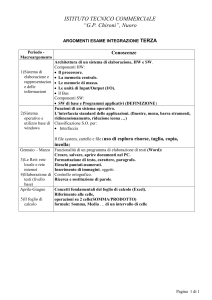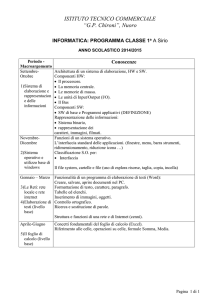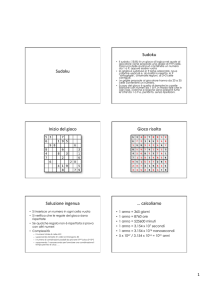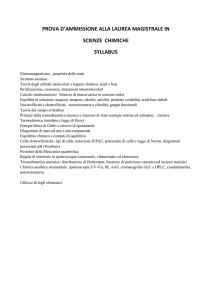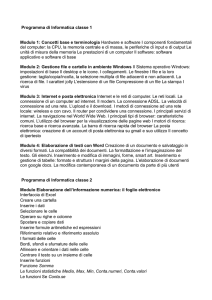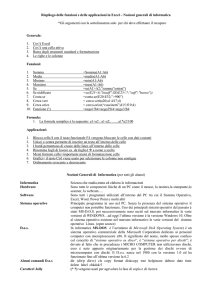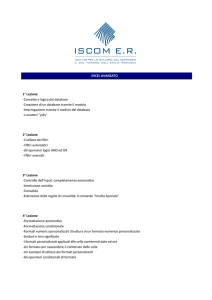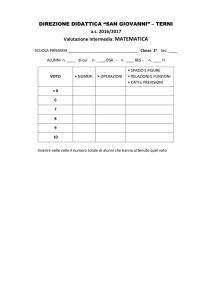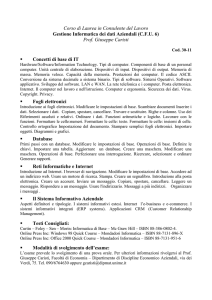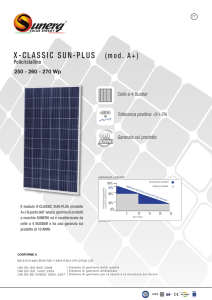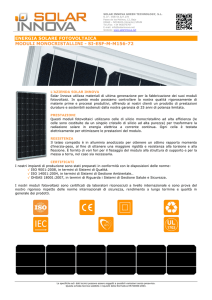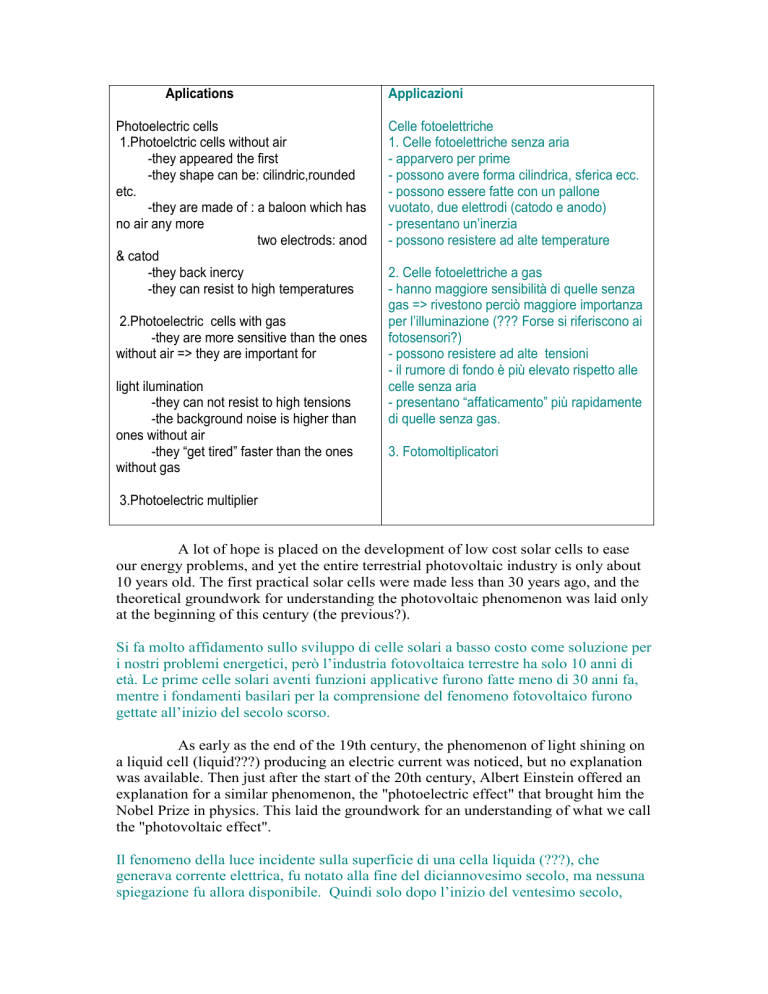
Aplications
Photoelectric cells
1.Photoelctric cells without air
-they appeared the first
-they shape can be: cilindric,rounded
etc.
-they are made of : a baloon which has
no air any more
two electrods: anod
& catod
-they back inercy
-they can resist to high temperatures
2.Photoelectric cells with gas
-they are more sensitive than the ones
without air => they are important for
light ilumination
-they can not resist to high tensions
-the background noise is higher than
ones without air
-they “get tired” faster than the ones
without gas
Applicazioni
Celle fotoelettriche
1. Celle fotoelettriche senza aria
- apparvero per prime
- possono avere forma cilindrica, sferica ecc.
- possono essere fatte con un pallone
vuotato, due elettrodi (catodo e anodo)
- presentano un’inerzia
- possono resistere ad alte temperature
2. Celle fotoelettriche a gas
- hanno maggiore sensibilità di quelle senza
gas => rivestono perciò maggiore importanza
per l’illuminazione (??? Forse si riferiscono ai
fotosensori?)
- possono resistere ad alte tensioni
- il rumore di fondo è più elevato rispetto alle
celle senza aria
- presentano “affaticamento” più rapidamente
di quelle senza gas.
3. Fotomoltiplicatori
3.Photoelectric multiplier
A lot of hope is placed on the development of low cost solar cells to ease
our energy problems, and yet the entire terrestrial photovoltaic industry is only about
10 years old. The first practical solar cells were made less than 30 years ago, and the
theoretical groundwork for understanding the photovoltaic phenomenon was laid only
at the beginning of this century (the previous?).
Si fa molto affidamento sullo sviluppo di celle solari a basso costo come soluzione per
i nostri problemi energetici, però l’industria fotovoltaica terrestre ha solo 10 anni di
età. Le prime celle solari aventi funzioni applicative furono fatte meno di 30 anni fa,
mentre i fondamenti basilari per la comprensione del fenomeno fotovoltaico furono
gettate all’inizio del secolo scorso.
As early as the end of the 19th century, the phenomenon of light shining on
a liquid cell (liquid???) producing an electric current was noticed, but no explanation
was available. Then just after the start of the 20th century, Albert Einstein offered an
explanation for a similar phenomenon, the "photoelectric effect" that brought him the
Nobel Prize in physics. This laid the groundwork for an understanding of what we call
the "photovoltaic effect".
Il fenomeno della luce incidente sulla superficie di una cella liquida (???), che
generava corrente elettrica, fu notato alla fine del diciannovesimo secolo, ma nessuna
spiegazione fu allora disponibile. Quindi solo dopo l’inizio del ventesimo secolo,
Albert Einstein fornì una spiegazione per un tale fenomeno, l’”effetto fotoelettrico”,
che lo portò a ottenere il premio nobel per la fisica. Ciò gettò le basi per la
comprensione di quello che ora chiamiamo „effetto fotovoltaico”.
To observe the photoelectric effect, light was shined on a metal surface, and
an electric current could be detected coming off the metal. Einstein explained the
observed phenomenon by capitalizing on the recently introduced idea of "quantized"
energy levels, and described light itself as being made of a flow of minuscule
"photons" or particles of light energy. When photons impinge on a metal, some
"knock out" electrons from metal atoms, much like a billiard ball will knock another
ball away when the two collide.
Per osservare l’effetto fotoelettrico, la luce deve illuminare una superficie metallica e
una corrente elettrica proveniente dal metallo deve essere rilevata. Einstein colse
l’idea da poco introdotta dei livelli energetici „quantizzati” e descrisse la luce stessa
come fatta di una corrente di minuscoli "fotoni” o particelle di energia luminosa.
Quando i fotoni urtano la superficie del metallo, alcuni sono espulsi dagli atomi del
metallo, similmente all’urto di una palla da biliardo che espelle un’atra palla che viene
colpita.
Further application of the quantum concept led to the development during
the 1930's of a whole new way of dealing with matter and energy called Quantum
Mechanics. This science was used to develop the new solid state technology that
pervades our lives today. Key discoveries made at the Bell Telephone Research
Laboratories in the mid-1950's led to the transistor and the first practical solid state
solar cell.
Ulteriori applicazioni dei concetti quantistici condussero allo svuluppo, durante gli
anni trenta, di un nuovo modo di considerare la materia e l’energia, chiamata
Meccanica Quantistica. La scienza è stata usata per sviluppare le nuove tecnologie
allo stato solido che pervadono la nostra vita moderna. Presso i laboratori della Bell
Telegraph Company furono fatte, a metà degl anni 50, le scoperte chiave da cui
scaturirono i transistor e la prima cella solare.
The space race of the late 1950's and 1960's spurred improvements in solar
cell design and efficiency. The cells were perfect sources of electric power for
satellites because they were rugged, lightweight and could meet the low power
requirements reliably. However, the drive to make space qualified solar cells efficient
and lightweight led to high costs, making them uneconomical for use on the earth
where low price is the main concern. A few small modules were made using reject
space cells, but this was not a real advantage.
La corsa allo spazio dalla fine degli anni '50 e negli anni '60 stimolò miglioramenti
nella progettazione delle celle e nella loro efficienza. Le fotocelle rappresentavano
delle fonti perfette di energia elettrica per i satelliti artificiali perché esse erano
rudimentali, leggere e potevano adattarsi facilmente alle esigenze di bassa potenza.
Comunque la deriva verso la costruzione di celle solari efficenti condussero a costi
elevati che le resero antieconomiche per l’utilizzo terrestre, dove il costo è il
parametro d’interesse fondamentale.
Alcuni moduli furono realizzati utilizzando gli scarti delle celle spaziali, ma questo
non poté costituire un reale impatto sul consumo energetico.

